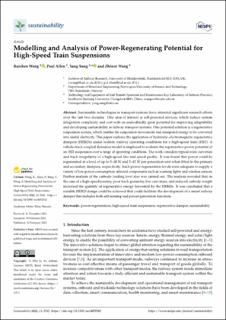| dc.contributor.author | Wang, Ruichen | |
| dc.contributor.author | Allen, Paul | |
| dc.contributor.author | Song, Yang | |
| dc.contributor.author | Wang, Zhiwei | |
| dc.date.accessioned | 2023-02-01T14:10:05Z | |
| dc.date.available | 2023-02-01T14:10:05Z | |
| dc.date.created | 2022-05-02T14:02:24Z | |
| dc.date.issued | 2022 | |
| dc.identifier.citation | Sustainability. 2022, 14 (5), . | en_US |
| dc.identifier.issn | 2071-1050 | |
| dc.identifier.uri | https://hdl.handle.net/11250/3047783 | |
| dc.description.abstract | Sustainable technologies in transport systems have attracted significant research efforts over the last two decades. One area of interest is self-powered devices, which reduce system integration complexity and cost with an undoubtedly great potential for improving adaptability and developing sustainability in railway transport systems. One potential solution is a regenerative suspension system, which enables the suspension movements and dissipated energy to be converted into useful electricity. This paper explores the application of hydraulic–electromagnetic regenerative dampers (HERDs) under realistic railway operating conditions for a high-speed train (HST). A vehicle-track-coupled dynamics model is employed to evaluate the regenerative power potential of an HST suspension over a range of operating conditions. The work considers typical route curvature and track irregularity of a high-speed line and speed profile. It was found that power could be regenerated at a level of up to 5–30 W and 5–45 W per generation unit when fitted to the primary and secondary dampers, respectively. Such power-regeneration levels were adequate to supply a variety of low-power-consumption onboard components such as warning lights and wireless sensors. Further analysis of the carbody loading level also was carried out. The analysis revealed that, in the case of a high-speed journey, poor track geometry, low curvature, and reduced carbody weight increased the quantity of regenerative energy harvested by the HERDs. It was concluded that a suitable HERD design could be achieved that could facilitate the development of a smart railway damper that includes both self-sensing and power-generation functions. | en_US |
| dc.language.iso | eng | en_US |
| dc.publisher | MDPI | en_US |
| dc.rights | Navngivelse 4.0 Internasjonal | * |
| dc.rights.uri | http://creativecommons.org/licenses/by/4.0/deed.no | * |
| dc.title | Modelling and Analysis of Power-Regenerating Potential for High-Speed Train Suspensions | en_US |
| dc.title.alternative | Modelling and Analysis of Power-Regenerating Potential for High-Speed Train Suspensions | en_US |
| dc.type | Peer reviewed | en_US |
| dc.type | Journal article | en_US |
| dc.description.version | publishedVersion | en_US |
| dc.source.pagenumber | 22 | en_US |
| dc.source.volume | 14 | en_US |
| dc.source.journal | Sustainability | en_US |
| dc.source.issue | 5 | en_US |
| dc.identifier.doi | 10.3390/su14052542 | |
| dc.identifier.cristin | 2020717 | |
| cristin.ispublished | true | |
| cristin.fulltext | original | |
| cristin.qualitycode | 1 | |

